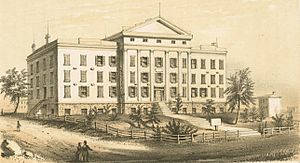Colored Orphan Asylum facts for kids
The Colored Orphan Asylum was a special home in New York City for children who didn't have parents or whose parents couldn't take care of them. It was open for a long time, from 1836 to 1946. On average, about 400 children lived there each year. Most of the people who ran the asylum were women.
The first building for the asylum was in Midtown Manhattan on Fifth Avenue. It was a four-story building. Later, the asylum moved to Upper Manhattan and then to Riverdale in the Bronx.

Colored Orphan Asylum in Midtown Manhattan in 1850.
|
|
| Successor | Riverdale Children's Association |
|---|---|
| Established | 1836 |
| Founders | Anna Shotwell, Hanna Shotwell, and Mary Lindley Murray |
| Founded at | Manhattan |
| Type | Orphanage |
| Location |
|
|
Region served
|
New York City |
|
Key people
|
Mary Lindley Murray, James McCune Smith |
| Affiliations | Hampton Institute |
Contents
A Home for Children in Need
The Colored Orphan Asylum was started in Manhattan in 1836. It was founded by three women who were part of a religious group called Quakers. Their names were Anna Shotwell, Hanna Shotwell, and Mary Lindley Murray.
This asylum was one of the very first places in the United States to welcome Black children who had lost their parents. Before it opened, many orphaned Black children had nowhere safe to go. They might have ended up in jails or had to beg for food. Other orphanages at the time often refused to take them in.
Education and Skills
When the asylum first opened, it only offered schooling for very young children. Older children were part of a system where they went to live with families. They would work for these families to learn a trade or a skill. This system was called indentured servitude. The families would pay a small fee to the asylum. This money was saved for the child until they left the asylum at age 21.
Over time, the education offered at the asylum improved. By 1897, children could go to school up to the sixth grade. Some students even went on to study more at the Hampton Institute. In 1918, schooling was offered up to the eighth grade. The system of children working for families also changed. It became more like a foster care system, where children were meant to become part of the family and continue their studies.
In 1846, Dr. James McCune Smith joined the asylum as its medical director. He was the first licensed African American medical doctor in the country.
The 1863 Riots
In 1863, during the American Civil War, the government made new rules about joining the army. People were chosen by a lottery system. If you were chosen, you could pay money or find someone else to go in your place. But many working-class men could not afford this. At the same time, Black men were not allowed to join the army because they were not seen as citizens.
This made many working-class white men very angry. They started protests and attacked government buildings and Black neighborhoods. On July 13, 1863, during these protests, a large group of people attacked the Colored Orphan Asylum. They burned the building down. A police officer helped lead the children to safety out the back door, but he was killed during the attack.
Rebuilding and New Beginnings
After the riot, the Quakers helped rebuild the asylum. It reopened in 1867 on 143rd Street in Manhattan.
In 1907, the asylum moved to a new location in Riverdale, Bronx. At this new site, they tried a different way of housing the children. Instead of one big building, they had several smaller cottages. Each cottage had about 25 children and a housemother. This new plan was very popular because it made the children feel more at home and encouraged them to be independent.
In 1910, the asylum bought a farm in Dutchess County. Boys from the asylum could go there to learn practical skills like farming.
In 1944, the asylum changed its name to the Riverdale Children's Association. By 1946, it became an agency that focused on finding foster homes for children. The building in Riverdale later became a home for older people.
Images for kids




